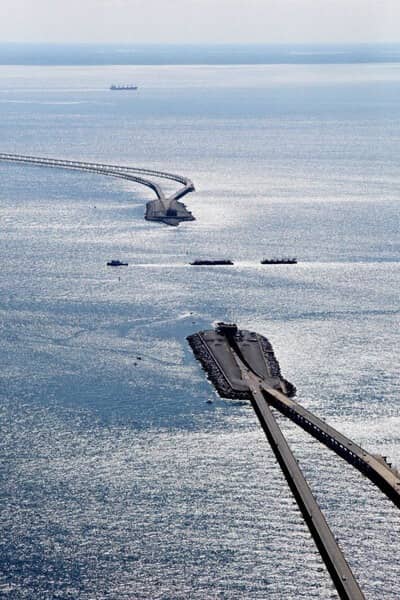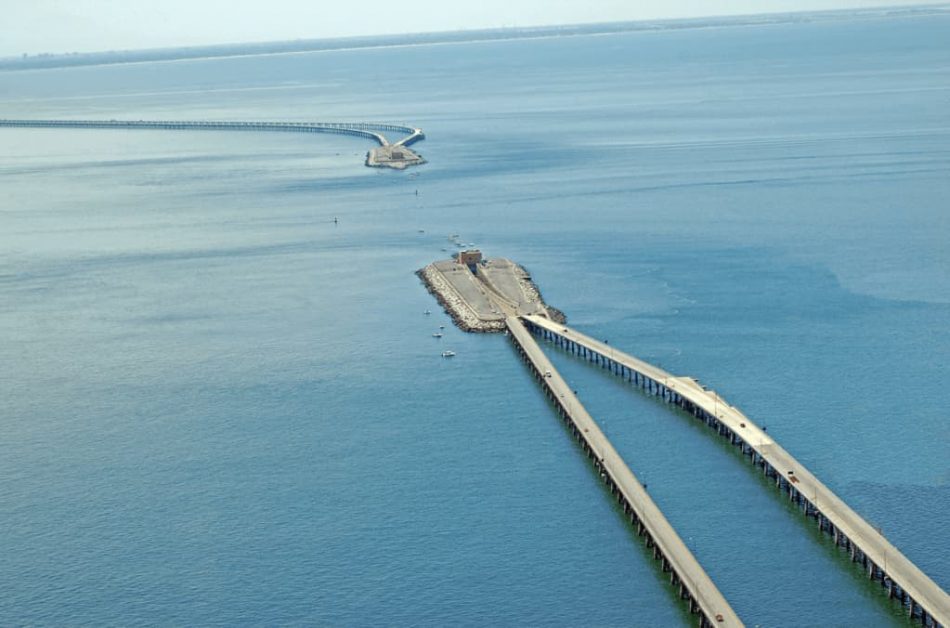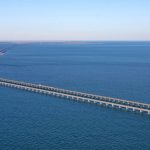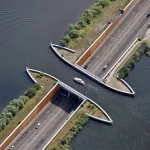The Chesapeake Bay Bridge-Tunnel (CBBT) is a true engineering marvel and one of the most iconic landmarks in Virginia. This 17.6-mile (28.3 km) bridge-tunnel complex connects the Virginia mainland at Virginia Beach near Norfolk to Virginia’s Eastern Shore at Cape Charles. It opened in 1964, replacing a ferry service that had operated since the 1930s. Chesapeake Bay Bridge-Tunnel is the longest underwater tunnel in the United States and one of only 12 bridge-tunnel systems in the world. The CBBT saves motorists about 95 miles on trips between Hampton Roads and the Delaware Valley.
| Location | Chesapeake Bay, Virginia, USA |
| Carries | 4 lanes (2 in tunnels) |
| Length | 17.6 miles (28.3 km) |
| Opened | April 15, 1964 |
| Toll | Cars $14 |
The CBBT is a major engineering feat, with two one-mile (1.6 km) tunnels beneath the Thimble Shoals and Chesapeake navigation channels, two pairs of side-by-side high-level bridges over two other navigation channels, and 12 miles (19 km) of low-level trestle. The total length of the bridge-tunnel system is 23 miles (37 km), making it one of the longest bridges in the world.
The 5 Longest Underwater Tunnels in the World
Laerdal, The Longest Tunnel in the World
The CBBT is a toll road, with tolls for both cars and trucks. However, there are discounts for E-ZPass users and for those who travel during off-peak hours. Whether you are traveling for business or pleasure, the Chesapeake Bay Bridge-Tunnel is a must-see destination. It is an engineering marvel, a beautiful natural landmark, and a popular tourist attraction.
Construction
 The construction of the CBBT was a major undertaking that took 42 months to complete. The project faced a number of challenges, including the need to excavate soft mud and sand, build artificial islands, and lay underwater tunnels. The tunnels were constructed using a technique called “cut and cover.” First, a trench was dug for each tunnel. Then, prefabricated sections of the tunnel were lowered into the trench and joined together. The final step was to fill in the trench and cover it with concrete.
The construction of the CBBT was a major undertaking that took 42 months to complete. The project faced a number of challenges, including the need to excavate soft mud and sand, build artificial islands, and lay underwater tunnels. The tunnels were constructed using a technique called “cut and cover.” First, a trench was dug for each tunnel. Then, prefabricated sections of the tunnel were lowered into the trench and joined together. The final step was to fill in the trench and cover it with concrete.
The CBBT is a popular tourist destination, and drivers can stop at scenic overlooks and fishing piers along the way. The bridge-tunnel is also home to a variety of wildlife, including birds and fish.
The high-level bridges were constructed using a technique called “cantilever construction.” Crews built out from each side of the navigation channels until the bridges met in the middle. Each bridge is supported by steel towers that are anchored to the seabed.
Opening and Expansion
The CBBT opened to traffic in April 1964. It was immediately hailed as a major engineering achievement and a boon to the economy of Hampton Roads. In 1995, construction began on a parallel crossing project to accommodate increasing traffic demands. The project was completed in 1999, and the parallel bridges and trestles were opened to traffic in April of that year.
Current Status
The CBBT is a vital link between the Virginia mainland and Virginia’s Eastern Shore. It carries over 30 million vehicles per year and is an important economic driver for the region. The CBBT is also a popular tourist destination. Visitors can enjoy stunning views of the Chesapeake Bay, fish for a variety of saltwater species, hike on the trails at the two rest areas, and picnic in the picnic areas.
Future Plans
The CBBT Commission is currently working on a project to dualize the Thimble Shoal Tunnel. The project is expected to be completed in 2024 and will create a four-lane tunnel for traffic. The CBBT is a remarkable example of human ingenuity and engineering. It has transformed the way people travel between Virginia’s mainland and Eastern Shore and has become a popular tourist destination. The CBBT is sure to continue to be an important part of the region for many years to come.













